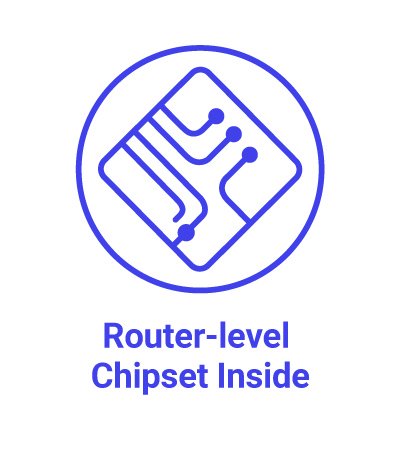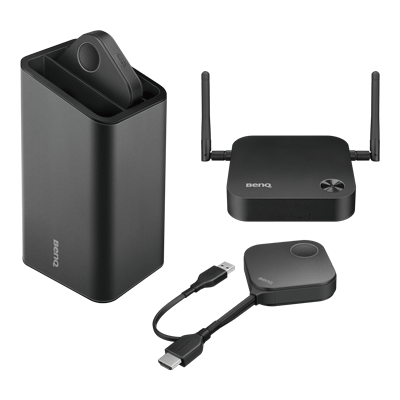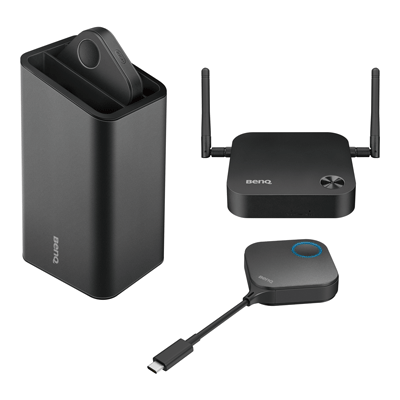How Financial Organisations Can Protect the Wireless Presentation Systems from Data Leaks and Other Vulnerabilities
- BenQ
- 2022-12-19


In purely practical terms, the financial sector is one of the most sensitive industries with regard to lapses in cybersecurity. From hackers exposing customer data to leaks of impending IPOs, any type of data breach or even the appearance of such breaches could be fatal to the financial institution's reputation and even possibly put them in legal jeopardy. At the same time, the financial sector is also one of the most susceptible industries to breaches in data security, with roughly two-thirds of over 60 global banking and financial firms have faced at least one serious cyber security attack in a year according to a recent analysis.
What this means is that any organisation working in the industry has to be relentlessly vigilant with their data, ensuring that any digital hardware that their data might pass through – especially commonly overlooked but frequently used equipment, such as a wireless presentation system (WPS) – is armed with security features that can prevent any possible breaches. Furthermore, in anticipation of any new threats that may develop in the future, the same organisations should also look to utilise higher-performing equipment with forward-thinking technology that will be able to deal with any potential threats once they appear on the scene.
The Most Common Data Security Threats for the Financial Sector

For banks and financial services companies, the most common threats to their data security tend to fall into two general categories: data breaches and network infiltration. Data breaches, in terms of wireless presentation systems, mean intrusions into the wireless connection between the transmitting device of the WPS and its receiver that result in data leaks and the stealing of data. Network infiltration on the other hand means taking advantage of the same wireless connection to break into the entire organisation’s network. Knowing this, it is incumbent on the IT staff of each organisation to procure only WPS equipment that can effectively address these types of threats.
How a Wireless Presentation System Can Address Data Security Threats
Given the threats described above, what features should IT staff look for when considering the type of wireless presentation system that their organisation will employ?

First, there are features that are indispensable to wireless data security and thus should be a prerequisite for any WPS under consideration by the IT team. They include a built-in router chip which allows for a stand-alone wireless signal between the transmitter and receiver that is completely isolated from the organisation’s network and thus prevents the possibility of network infiltration. Another prerequisite is a WPS solution that does not require any additional software or driver installation on the user’s device, this would sideline the chances of data breaches via third-party software.

Beyond these essential components, data encryption also plays a major role in protecting data in a wireless network. Depending on the levels of security, data encryption technology has a range that covers basic Wi-Fi WPA to hardware-based security. If your WPS will carry the most sensitive type of data, you should choose a hardware-based security solution. Unlike standard Wi-Fi WPA data encryption, a hardware-based solution stores a cryptographic key in the security chipset that is built into the endpoint WPS receiver.
But, how can one ensure that the security chipset is safe? There are data protection standards that provide guidelines to help you in your decision-making process when considering which WPS solution to purchase. In the United States, the NIST (National Institutes of Standards and Technology) has established the FIPS 140 standard, while the EU Cybersecurity Act has also established a cybersecurity certification framework which is mapped to the Common Criteria evaluation levels (as shown in the table below). For example, when using a WPS that requires the highest degree of security, it is suggested that your security chipset is at the EAL 4+/5+/6 level.
The EU cybersecurity certification framework by EU Cybersecurity Act
CC Evaluation Level |
Attack Potential |
Security Level |
CC Evaluation Level EAL 2/3 | Attack Potential Basic | Security Level - |
CC Evaluation Level EAL 2+ / 3+ / 4 | Attack Potential Enhanced Basic | Security Level Low |
CC Evaluation Level EAL 3+ / 4+ / 5 | Attack Potential Moderate | Security Level Substantial |
CC Evaluation Level EAL 4+ / 5+ / 6 | Attack Potential High | Security Level High |
Source: BSI Study 2017
How InstaShow WDC30 Provides the Enterprise-Level Protection

Two-way transmitter-receiver authentication with a mutual handshake (via the exchange of certificates) which creates an encrypted tunnel after authentication is complete
Based on the security features detailed above, BenQ’s InstaShow WDC30 wireless presentation system is guaranteed to offer a level of protection not seen in other WPS devices. InstaShow WDC30’s data protection starts with the indispensable building blocks of a discrete router chip that allows for a wireless signal sequestered from the organisation’s network, software-free installation, and an authentication procedure that ensures that only the right devices can connect. Then once authenticated, the connection and subsequent data transfers are then protected by InstaShow WDC30’s FIPS 140-3 and EAL6+ certified cryptographic algorithm, with the cryptographic key stored on an EAL6+ certified security chipset.
Even though InstaShow WDC30 checks all the data security boxes listed above, there are some additional features that BenQ has loaded onto the device to further its optimisation, including the use of the newest and fastest Wi-Fi 6 wireless signal – which also means utilisation of Wi-Fi 6’s built-in advanced encryption features – as well as a “cut-off” button which allows you to disable connections from BYOD mobile devices for increased protection.
For a better understanding of the extent of InstaShow WDC30 features, see the specifications table below.
Find the Best InstaShow Model for You
Model |
WDC10 / WDC10C |
WDC20 / WDC20C |
WDC30 |
Model Meeting Type | WDC10 / WDC10C Huddle Room Meeting | WDC20 / WDC20C Huddle Room Meeting | WDC30 Large-Size Room for confidentiality-sensitive meeting |
Model WiFi Standard | WDC10 / WDC10C WiFi5 | WDC20 / WDC20C WiFi5 | WDC30 WiFi6 |
Model Distance | WDC10 / WDC10C 8m | WDC20 / WDC20C 15m | WDC30 30m |
Model Output Resolution | WDC10 / WDC10C 1080p@60fps | WDC20 / WDC20C 4K@30fps | WDC30 4K@60fps |
Model B.Y.O.D | WDC10 / WDC10C N/A | WDC20 / WDC20C Airplay/ Google Cast/ BenQ InstaShare App | WDC30 Airplay/ Google Cast/ BenQ InstaShare App |
Model Max Connection | WDC10 / WDC10C 16 | WDC20 / WDC20C 32 | WDC30 64 |
Model Button Interface | WDC10 / WDC10C HDMI+USB Power or USB Type C | WDC20 / WDC20C HDMI+USB Power or USB Type C | WDC30 HDMI+USB Power |
Model WiFi Encryption | WDC10 / WDC10C WPA2 | WDC20 / WDC20C WPA2 | WDC30 WPA3 |
Model WiFi Security Certificate | WDC10 / WDC10C N/A | WDC20 / WDC20C N/A | WDC30 · CC EAL6+(ISO/IEC 15408) · FIPS 140-3 |
Model Others | WDC10 / WDC10C N/A | WDC20 / WDC20C HID Touchback Support | WDC30 · HID Touchback Support · Certified Germ Resistance |

